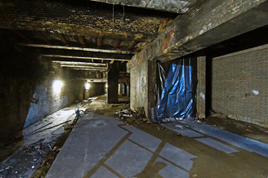These are shocking revelations, as is the fact that the time of day a soldier was killed was significant. If they had died in the morning the War Office decreed their next of kin would only receive half the day’s pay.
It’s a history lesson that will always stay with me, although I must confess to a connection that made it even more poignant for me. My maternal grandfather served in the Black Watch during the First World War. He was gassed and returned an invalid, dying before I was born.
While still trying to absorb everything we’d been told, we move on to somewhere completely different. Underneath the main platforms, parallel to the Clyde, lie two island platforms which were added to serve the independent Glasgow Central Railway.
They opened in 1896 but closed in 1964 because trams had stolen their passengers. One of the islands reopened in 1979 as part of the newly-electrified Argyle line. The other platform is bricked off and abandoned. This is where Lyons takes us.
You reach it through a door off one of the passages in the low-level station. From there a new metal staircase has been installed to allow safe access to the platform below, replacing the single ladder which was used before. It really is quite an eerie place, and is still very much abandoned - the rails have been ripped up and the trackbed is clogged with the usual detritus of a disused railway.
Apparently, it was always a forbidding place. Lyons tells stories of women having their handbags stolen by thieves who would conceal themselves behind the smoke and steam from engines. It was so unsafe that a women-only waiting room had to be created.
You can still see the smoke stains from the locomotives on the roof, and sense what an unpleasant place it must have been to use. But all this is about to change, as Lyons explains when he takes us into a nearby chamber.
Soon, the area will be rejuvenated and restored. The track will be replaced to allow an old coach to be brought in as a centerpiece, helping to re-create the feel of a railway station. An adjoining room will be converted into a museum to display the many old pictures and artifacts that have been found, or donated by people (you can see some examples on the gallery page of the website).
Lyons views this not just as a museum about the station building, or even the railway, but as a museum about the people of Glasgow and their relationship with the building through the ages. He loves to hear anecdotes and personal stories from visitors, and actively encourages people to tell them. The hope is to include many of these as part of the museum. Other plans include conducting tours of the massive station roof, which would give a completely different perspective of the building.
The projects have received encouragement from many sides, and the tours are starting to receive the media attention that they deserve. Even Network Rail’s Chief Executive Mark Carne has taken a tour and offered his support. Now there are plans to open other Network Rail stations to similar schemes, among them Edinburgh Waverley.
I thoroughly recommend the tour to anyone who has an interest in either railways, architecture or social history – or who simply enjoys being enthralled by a storyteller!
- You can book a tour or find out details about the progress of new attractions by visiting the website at www.glasgowcentraltours.co.uk
This feature was published in RAIL 820 on 11th February 2017














Login to comment
Comments
Derek - 30/01/2020 17:26
Absolutely must do tour , Paul is so passionate about the stations history, he leaves you wanting more.